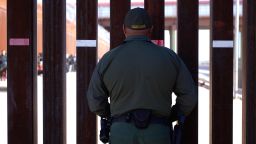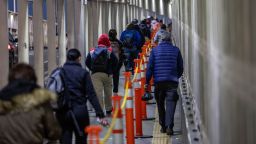Editor’s Note: Anna Lekas Miller, a journalist covering refugee and immigration issues, is the author of the upcoming book, “Love Across Borders,” a collection of refugee and immigrant love stories. The views expressed in this commentary are her own. View more opinion on CNN.
As the Title 42 immigration policy ends, it seems as if there might be good news for people hoping to seek refuge in the United States.

Under the policy put in place during the pandemic, the US Customs and Border Protection (CBP) agency was authorized to expel migrants before they even had a chance to apply for asylum. Over the past three years, law enforcements agencies have used this policy to facilitate more than 2.6 million expulsions to Mexico, where migrants have faced threats from gangs and cartels that kidnap and extort them for ransoms. According to Human Rights First, a nonprofit organization, since President Joe Biden was inaugurated, there have been at least 13,480 cases of murder, rape, torture and kidnapping related, at least in part, to Title 42 expulsions.
However, now those waiting at the border will likely be subject to a new rule that will require them to seek asylum in the first “safe” country they arrive in, effectively barring all non-Mexican migrants who arrive at the border from the asylum process. Immigration advocates have pointed out that this policy is absurd. Most of the allegedly “safe” countries that people would pass through struggle with similar kinds of violence and have few protections in place for migrants and refugees.
I find myself wondering what this moment might look like if the history of passports had turned out differently. What if people from countries like Honduras, Venezuela, Nicaragua, Haiti and Mexico had the same freedom of movement as people from the United States?
To be honest, I have been thinking about this question ever since I first met my now-husband, Salem, whose Syrian passport has meant that he enjoys far less freedom of movement than myself. While it wasn’t a problem when we first fell in love in Istanbul, it reared its ugly head when the Turkish government started cracking down on Syrian refugees and kicked him out. We couldn’t immigrate to the US at the time due to former President Donald Trump’s ban on immigrants from Syria and other Muslim-majority countries, and we eventually moved to the United Kingdom, where Salem was able to seek asylum.
While I know we were lucky to find a country where we could be together, I shudder to think of what could have happened if I didn’t have a US passport – and therefore the freedom of movement to follow him from country to country.
As it turns out, passports – and, crucially, the way they divide the world into a class of people who can move freely and a class of people who cannot – are a shockingly recent institution. While identity documents have existed in some form since antiquity, passports as a standardized requirement to cross borders went into effect during World War I as a temporary national security measure. After the war, it initially seemed passports might be abolished, as the desire to return to a world with freedom of movement was weighed against the need for national security.
Unfortunately, this was not the case. Shortly thereafter, the United States passed the 1924 Immigration Act, which authorized immigration quotas that severely limited immigration from Southern Europe and Eastern Europe, while continuing to facilitate immigration from Northern and Western Europe. Many of the lawmakers advocating for the quotas wanted to use immigration control as a means to maintain a White, Anglo-Saxon majority.
While the 1924 Immigration Act did not impose quotas on immigration from the Americas, that same year Congress established Border Patrol, which was charged with securing the northern and southern borders between inspection stations. These agents, some of whom had been recruited from both local police forces and White nationalist vigilante groups, started experimenting with arbitrary and often cruel immigration enforcement tactics, including subjecting Mexican nationals to sudden fees and degrading hygiene inspections.
As a result, many of those who were accustomed to freely crossing the border stopped using official crossings. At first, most law enforcement turned a blind eye to “illegal immigration,” but when the US government officially criminalized it in 1929 – and made it a deportable offense – immigration status became a weapon to crack down on Mexican communities, first along the border, and later, throughout the country.
As time marched on, the policies around the US border expanded to the Caribbean to try to deter Haitians fleeing Jean-Claude Duvalier’s dictatorship on makeshift boats. The US government piloted the tactic of detaining asylum-seekers in immigration detention centers in Florida, and later, at Guantánamo Bay.
Frequently, Haitians were sent back – a stark contrast to Cuban refugees fleeing Fidel Castro’s dictatorship, who were granted asylum, financial assistance and a path to permanent residency. Refugees were in the cross hairs of the Cold War; while Cubans benefited from the US government’s commitment to fight communism and Soviet expansion, Haitians lost.
Now, the estimated tens of thousands of people who are currently camping along the border are living the consequences of this history of experiments in immigration enforcement. As we wait to see what happens next, one thing is certain – their passports will play a critical role in determining their futures in, and out, of the United States.
And while national security is undeniably important, it has reached a point where it is being used as an excuse to make blanket assumptions about people based on the passports that they hold, separating families and not allowing immigrants – including refugees in need of protection – to reach their full potential. Though our political conversation around immigration often focuses on how to stop the root causes of migration or the economic strain of newcomers, it rarely questions what could be done to ensure that these newcomers could settle and contribute, as quickly and painlessly as possible.
Get Our Free Weekly Newsletter
- Sign up for CNN Opinion’s newsletter
- Join us on Twitter and Facebook
In fact, state governments are taking steps that could severely complicate the political asylum process as we know it and make life even more difficult for immigrants who are already in the United States. For example, in Florida, which is home to the largest communities of Haitians, Venezuelans and Cubans in the country, a law is currently being considered that would make it a felony to shelter, hire or transport undocumented immigrants.
In Texas, another state where Mexican and Honduran communities are a significant part of the population, Gov. Greg Abbott is trying to move much of immigration enforcement to a state, rather than a federal force. Advocates point out that such a shift is legally questionable and would allow the state to employ untrained civilians. Those civilians, they warn, may feel empowered to racially profile anyone who looks like a migrant, instilling fear in border communities.
As we move into a new era of immigration enforcement, it is time to question what is really causing the “crisis” at the border – and how we imagine a world beyond it. Is it the people who have fled war, economic crises and, increasingly, the disastrous impact of climate change? Or is the true crisis a world that won’t grant them freedom of movement in the first place?





